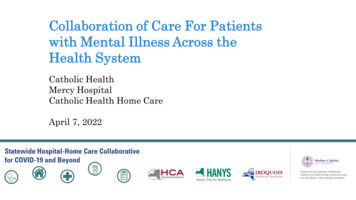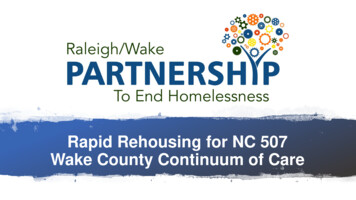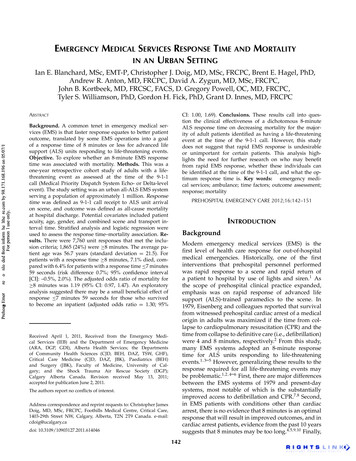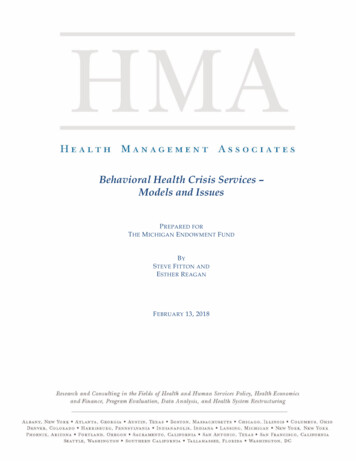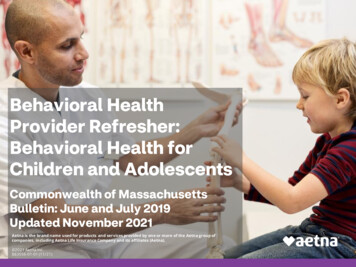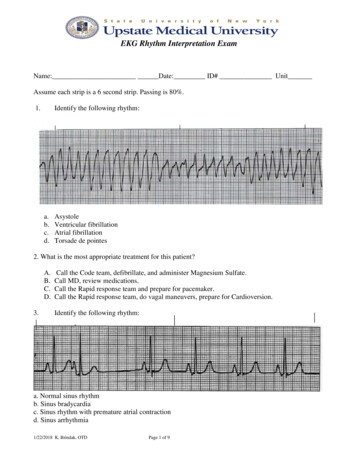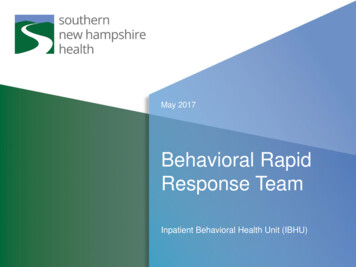
Transcription
May 2017Behavioral RapidResponse TeamInpatient Behavioral Health Unit (IBHU)
PresentersMichael Gallagher, BSN, NE-BCDirector of Behavioral Health ServicesMichelle Gardner, BSN, RN-BC, NE-BCClinical Manager Inpatient Behavioral Health UnitLisa McCarthy, MBA, BSN, RN-BCClinical Manager Inpatient Behavioral Health Unit
Our Discussion for TodayExplore and discuss:o history of the Behavioral Rapid Response Team (BRRT)o roles of the BRRT memberso criteria for the implementation of a BRRTo BRRT Education and Training
Our Organizationo Southern New Hampshire Medical Center is a 188-bed acute carefacility in Nashua, NH that includes a licensed 30-bed voluntaryinpatient Behavioral Health Unit.o Our medical staff includes nearly 500 primary and specialty careproviders serving more than100,000 patients each year from 32towns within southern NH and northern MA.
Our IBHU TodayThe Inpatient Behavioral Health Unit is a short-stay, crisis-stabilizationunit, which provides 24-hour care, 7 days a week.o 18-bed voluntary adult psychiatric unito Average length of stay: 7.5 dayso Physical layout consist of 3 hallways on the same levelo Staffing ratioo Day Shift:o Evening Shift:o Night Shift:3 RNs, 2 BHAs / RT, SW, MDs,security3 RNs, 2 BHAs, security2 RNs, 2 BHAs, security
Our Philosophy of Careo Promote a safe, restraint/seclusion-free environmento Consistently support respectful behaviors by intervening early, usingnegotiation skills, and providing least restrictive interventionso Facilitate a team approach that relies on excellent communicationskills and consistent use of Management of Aggressive Behavior(MOAB)
Have you ever o been involved in a restraint and/or seclusion?o had to deal with an aggressive patient?o been the lead when dealing with an aggressive patient?o wished your intervention was more organized?
Our Challengeo Relocated unito Limited structure to manage patients’ agitation and disruptivebehaviorso Nursing staff felt unsafe
Our Starting PointIn 2008:o IBHU was a 30 bed unito 7 cases of restraintso 2 cases of locked door seclusiono 9 cases of minor assaults to staffo Adopted IHI Rapid Response Team approacho Implemented BRRT in IBHU
Our Strategyo Promote safety through early interventiono Assure use of least restrictive measureso Mitigate the use of restraints and seclusionso Eliminate assaults and injuries
Our Solution:Behavioral Rapid Response TeamBehavioral Emergencies: any behavior which is escalating orpotentially escalating and potentially harmful to self, others, and/orto property.Goal: To initiate early interventions, promotesafety, and prevent escalation in any given situation.Team: The Behavioral Rapid Response Teamis comprised of staff that bring critical assessmentand intervention skills to the emergent situation.
Our Resultso Increase in:o staff satisfactiono unit safetyo patient satisfaction with treatment teamo BRRT Interventionso Decrease in:o restraint and seclusion useo staffing requirements (1:1)o Number of assaults and injuries
BRRT Structure
Key Pointso All BHU staff are included as part of the BRRTo Resource RN monitors and maintains safety for allo Roles are based on individual staff strengthso BRRT includes security and engages environmental and foodservices as needed
Where We BeginShift assignments on the white boardoNegotiation TeamoMedicationsoMilieu ManagementoStation Safetyo(Safety Team)
Negotiation Teamo Demonstrates strength in communication and negotiationo Conducts front line interventions with patiento Connects with patient – only one staff to speak at a time!o Addresses physical/psychological needso Helps patient meet criteria for and recognizes the patient’s readinessfor continuing independence in the milieuo Offers/administers meds; obtains new med orders
Medication Teamo Works with the negotiatoro Offers/administer meds; obtain new orders
Milieu Managemento Conducts 15-minute safety checkso Engages all other patientso Monitors patient’s behavior from stable/calm to signs ofanxiety/agitationo Moves other patients away from the situation to decreasestimuli/audience and maintain area safetyo Engages other patients with “bag of groupactivities”
Station SafetyServes as communication liaisono Updates social workers, doctors, ancillary staffo Directs visitorso Coordinates with kitchen staffo Pages “BRRT to BHU”
Safety Teamo Staff and Security – MUST BE MOAB TRAINEDo Visible presenceo Maintain safetyo Escort patient if required
Post BRRT InterventionShift Huddleo Consistencyo Unit safetyo Treatment planDe-escalation & Debrief
BRRT Guidelines
Behavioral Rapid Response Team (BRRT)An Early “BeRRT” Keeps the Peace
Organizational Expectationso Hospital-wide zero tolerance for violenceo Enhanced communication during shift handoffo Recognize and respond to behaviors with potential for escalation
Activationo Inter-shift report IPASSo Shift handoff huddleo Communication throughout the shifto Verbal notification of BRRT in progresso Individualized patient and milieu care
Education and Training
Educationo Online BRRT Educationo Simulation classo Annual review
Trainingo Inter-professional mock codeso Hospital-wide MOAB training
Thank You
Behavioral Rapid Response Team Behavioral Emergencies: any behavior which is escalating or potentially escalating and potentially harmful to self, others, and/or to property. Goal: To initiate early interventions, promote safety, and prevent escalation in any given situation. Team: The Behavioral Rapid Response Team
